This extract has been taken from “The well – designed mixed garden”. A shrub or bush is a small- to medium-sized perennial woody plant. Unlike herbaceous plants, shrubs have persistent woody stems above the ground. “Tree Removal Berkeley CA“, provides all relevant information on planting the Shrubs.
Shrubs
Besides the topdressing and fertilizer for acid-loving plants described in this chapter’s opening section, additional fertilizing of shrubs is not routine in the mixed border. Some gardeners like to use a balanced organic fertilizer on flowering shrubs. Many great shrubs for the mixed garden fall into the acid-loving category. Virginia sweet-spire (Itea virginica), summer-sweet clethra ( Clethra alnifolia), dwarf fothergilla (Fothergilla gardenia) are among my very favorite shrubs to use in mixed gardens, and they all prefer acidic soil. These shrubs are fairly adaptable, though, and may only become chloro-tic after several years of growing in alkaline conditions without fertilizer. Often a simple application of cottonseed meal clears the problem up. Rhododendrons and hollies are a bit more particular and benefit from regular application of a complete acidic fertilizer. Roses can be fertilized with Epsom salts after pruning, which supplies magnesium to promote strong growth of new canes from the base. Some rose gardeners use equal parts of a homemade organic mixture, such as alfalfa meal, fish-meal, green sand, bone meal, and gypsum.

When pruning shrubs, it is important to know if they flower on current year’s wood or last year’s wood. If pruning occurs too early or too late, flower buds may be removed. Shrubs that flower on old wood should be pruned after the shrub flowers; this way, the plant has time to put on growth for flowering the next year. Shrubs that flower on new wood can be pruned both before (when dormant in early spring) and after flowering. Michael Dirr (1997-2002) has excellent lists of pruning times for shrubs in his illustrated encyclopedias . Most shrubs flower on old wood, particularly spring-flowering shrubs, including Hydrangea macrophylla, H. quercifolia, and certain species of Glethra, Fothergilla, Genista, Hamamelis (witch hazel), Itea Rhododendron, Spiraea, Syringa(lilac), Viburnum, and Weigela. Shrubs that flower on new wood include Hamamelis virginiana, Hydrangea arborescens and H. paniculata, Potentilla fruticosa, many roses, and summer-flowering Spiraea. Certain shrubs that actually die back to the base or have tip die back in Midwestern and northern gardens-such as Buddleia davidii, Caryopteris × clandonensis, Vitex agnus-castus var. latifolia, and certain species of Calicarpa and Lespedeza- also flower on new wood, fortunately.
These plants, which are sometimes referred to as die back or cut-back shrubs, should be cut back just as new growth is about to begin, to viable buds at the base of the stems if present, or, if top growth was completely killed, to within a few inches of the ground, for new growth was completely killed, to within a few inches of the ground, for new growth to emerge from the roots. Be patient. Some of these plants (Vitex agnus-castus var. latifolia, for one) can take their time and won’t emerge from the base until the ground gets really time and won’t emerge from the base until the ground gets really warm. It may be into May or later before signs of life are evident. Sometimes just the tips or portions of the upper sections of the shrub may be killed, particularly with Caryopteris × clandonensis. If this is the case, and plants are not killed completely back, it is often preferable to leave a woody framework at the base of the plant for a bit of height in the border, especially in coller climates. In such circumstances, simply cut off the dead portion of the stems. Some of the larger flowering branches from last season can be cut back to the base to make room for new flowering stems if needed.

A heavier pruning known as coppicing or stooling can also be beneficial to cut-back shrubs, shrubs that flower on new wood, or shrubs grown for their ornamental foliage or stems. This technique can help create a better habit, more flowering, brighter-colored stems, better fruit production, and bolder, more intensely colored foliage. To coppice a shrub or small tree, cut back the entire plant to 4-6 in. above ground about a month before growth begins. With the more tender cut-back shrubs, it is best to wait a bit longer, or until the buds are just starting to swell and severe cold weather is no longer a threat. Leave some buds to be safe, although many of the plants will return from below ground. Know the plant before you do this intense pruning- it should be at least one year old, and it’s best if it is vigorously growing. With weaker shrubs, it may be best to cut only one-third to one-half of the stems severely. This technique may not be desirable every season, depending on the climate or the gardener’s own objectives. After pruning, an application of composted organic matter or a balanced organic fertilizer can be beneficial.
Many shrubs grown for their outstanding foliage or stem color are often large-growing and need to be kept heavily pruned, not only for aesthetics but to maintain a more appropriate scale for the mixed border. Variegated or colorful foliage plants such as Catalpa bignonioides ‘ Aurea’, Sambucus race-mosa ‘Sutherland Gold’, or selections of Cotinus coggygria are outstanding with coppicing. Dogwoods grown for their colorful winter stems benefit from this technique as well.
Continue reading on Specialized pruning tools
